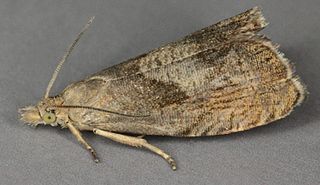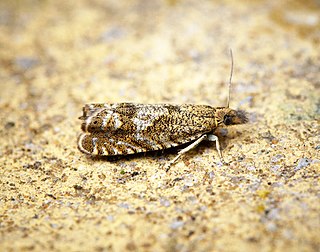
Dichrorampha acuminatana is a moth of the family Tortricidae. It is found in Europe and the Near East.

Dichrorampha simpliciana is a moth of the family Tortricidae. It is found in Europe and the Near East.

Notocelia rosaecolana is a moth of the family Tortricidae. It is found in the Palearctic realm, where it has been recorded from China, Mongolia, Korea, Japan, Iran, Central Asia, Russia and Europe.

Dichrorampha alpinana, the broad-blotch drill, is a species of moth of the family Tortricidae. It is found in almost all of Europe.

Cochylimorpha straminea, the straw conch, is a species of moth of the family Tortricidae. It is found in most of Europe, Morocco, Algeria, Tunisia, Asia Minor, the Palestinian territories, Iraq, Syria, Armenia, Transcaspia, Turkmenistan and Iran.
Tanymecica xanthoplaca is a moth in the family Copromorphidae, and the only species in the genus Tanymecica. It is found in Australia, where it has been recorded from Queensland.
Asthenoptycha heminipha is a species of moth of the family Tortricidae. It is found in Australia, where it has been recorded from Queensland.
Apocydia pervicax is a species of moth of the family Tortricidae. It is found in Australia, where it has been recorded from Queensland, New South Wales and the Northern Territory.
Toonavora aellaea is a species of moth of the family Tortricidae. It is found in Australia, where it has been recorded from Queensland and New South Wales.
Bactra psammitis is a species of moth of the family Tortricidae. It is found in Australia, where it has been recorded from South Australia and New South Wales.

Bactra optanias is a species of moth of the family Tortricidae first described by Edward Meyrick in 1911. It is found in Papua New Guinea, Australia, New Zealand, Java, Tahiti, Sri Lanka, New Caledonia, the Caroline Islands, the southern Mariana Islands, Rapa Iti and Micronesia.
Bactra testudinea is a species of moth of the family Tortricidae. It is found in Australia, where it has been recorded from Queensland.
Meritastis trissochorda is a species of moth of the family Tortricidae. It is found in Australia, where it has been recorded from New South Wales.
Holocola phaeoscia is a species of moth of the family Tortricidae. It is found in Australia, where it has been recorded from Queensland and New South Wales.
Noduliferola neothela is a species of moth of the family Tortricidae. It is found in Australia, where it has been recorded from Queensland.
Melanodaedala scopulosana is a species of moth of the family Tortricidae. It is found in India, Myanmar, Thailand, Vietnam, Japan, the Solomon Islands, Papua New Guinea and Australia, where it is found along the eastern coast from New South Wales to the Cape York Peninsula in Queensland.
Epinotia absconditana is a species of moth of the family Tortricidae. It is found in Australia, where it has been recorded from New South Wales and Queensland.

Gelophaula trisulca is a species of moth of the family Tortricidae. It is found in New Zealand.
Beryllophantis cochlias is a species of moth of the family Tortricidae. It is found in Papua New Guinea and West Irian. The habitat consists of montane rain-forests.

Dichrorampha plumbagana is a moth belonging to the family Tortricidae first described by Georg Friedrich Treitschke in 1830.







